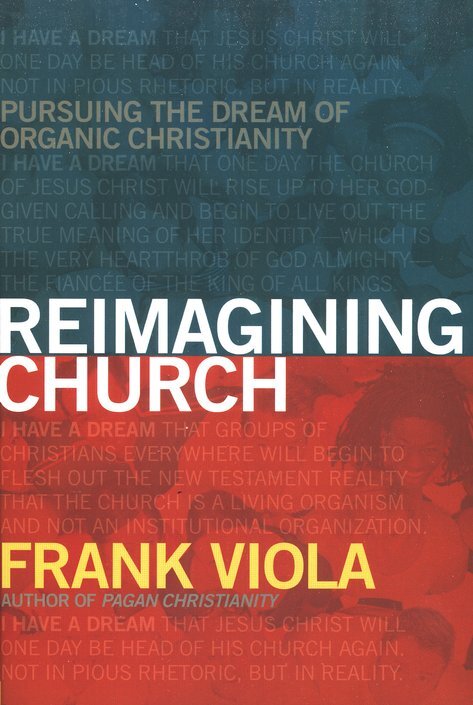Frank Viola, Reimagining Church: Pursuing the Dream of Organic Christianity. David C. Cook Publishing, 2008.
Prequel: Viola, Pagan Christianity
- Viola, From Eternity to Here
- Viola, Finding Organic Church
- Viola, The Untold Story of the New Testament Church
- Viola and Sweet, The Jesus Manifesto
Referenced in: Missional Communties – Organic Church
LifeandLeadership.com Summary
Reimagining Church is the second installment in Viola’s six-part of the “ReChurch Library.” It is the sequel to the controversial volume, Pagan Christianity, which exposed the present-day practices of the church, many of which have become ineffective, in terms of their origins in paganism. In Viola’s own words, Reimagining Church “paints a picture of church life where Jesus is in charge as the Head of His body.”
The difference between this volume and Pagan Christianity is important. Pagan Christianity expresses the postmodern deconstructive ethos, exploring the true historical roots of practices today’s church takes for granted, especially where they may have anchored missional ineffectiveness in the church. As a deconstruction, this volume was never intended to stand alone. It was only the first part of the argument. Reimagining Church is the second half which presents the constructive side, seeking to refocus the practices of the church into the teaching of Jesus and the apostles. Like the prequel, this book is a popular, highly acclaimed volume.
In Reimagining Church, Viola echoes many of the same sentiments as Neil Cole in the “Organic Church” model. They both argue that the first century church should be the pattern for the twenty-first century, primarily in the form of loosely organized house churches. He launches from Acts 2 and other descriptions such as 1 Corinthians 12-14 to derive several features of the true church: meeting in homes, no official pastor, everyone involved in worship, congregational/consensus decision making, no official leaders or elders but teachers and exemplars. They propose that returning to this kind of church requires abolishment of denominational systems along with their institutions such as professional clergy, buildings, doctrinal statements, corporate leadership structures, etc. Separate chapters address “reimagining” the church meeting, the Lord’s Supper, the gathering place, the family of God, church unity, leadership, oversight, decision-making, hieararchical/positional leadership structures, the apostolic tradition, etc.
For example, in the appendix, “Objections and Responses About Leadership,” he challenges the church’s tradition of hierarchical/positional leadership structures in the church. He suggests this is “partly the result of mistranslations and misinterpretations” that “have been influenced by cultural biases that have cluttered the original meaning of the biblical language. Such biases have transformed simple words into heavily loaded ecclesiastical titles. As a result, they have eroded the original landscape of the church.” (281) He suggests that a closer look at the original Greek yields the following insights: bishops are simply guardians (episkopoi), not high-church officials; pastors are caretakers (poimen), not professional pulpiteers; ministers are busboys (diakonos), not clergymen; elders are wise old men (presbuteros), not ecclesiastical officers.” (282) He then handles many of the anticipated objections and questions related to these positions.
Like its prequel, Pagan Christianity, this volume makes an important contribution to the discussion of how the church may be more effective in the postmodern era. It is also appropriate to be somewhat skeptical when someone claims to have discovered the “right” way of doing something that completely counters centuries of Christian practice. The observation from Alan Roxburgh in Introducing the Missional Church stands repeating, that “there is no model that is the way to do church.” (24) On the other hand, most reform requires a radical voice to spur us to rethink, or in this case, reimagine. Readers will benefit from this as a voice but not necessarily the voice in the process.
From the Publisher
Reimagining Church gives readers language for all they knew was missing in their modern church experience. Join Frank in this constructive follow-up to Pagan Christianity as he paints a compelling picture of organic church life, where the body of Christ is an organic, living, breathing organism. A church that is free of convention, formed by spiritual intimacy, and unbound by four walls. Leonard Sweet describes this book as a theology of church as organism rather than organization.
About the Author
Frank Viola is one of the most influential figures connected to the “New Revolution” of simple church and emerging house churches today. He is the author of six highly acclaimed books on radical church restoration, including Rethinking the Wineskin, Who is Your Covering?, Pagan Christianity, So You Want to Start a House Church?, and The Untold Story of the New Testament Church. Frank lives in Gainesville, Florida.
***For additional information on this resource, including reviews, click the bookstore links. Check the reference at page top or the links below for resource guides on related topics.***
Related Ministry Resource Guides:
- Missional Perspectives 01, Introduction
- Missional Church Resources, Introduction and Index
- Missional Philosophy
- Theology of Mission
- Missional Communities
- Missional Leadership / Missional Strategies
- Missional Lifestyle, Discipleship, Spirituality
- Church Leadership and Renewal, Index to Resources
- Ecclesiology
- Evangelism
See Resources on Over 100 Areas of Ministry Leadership:


